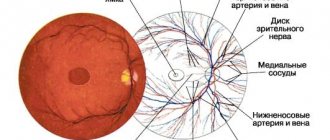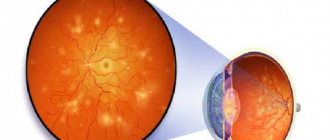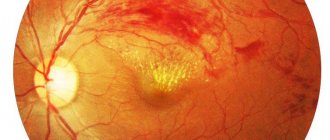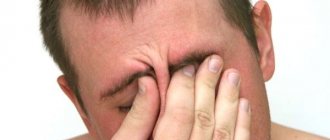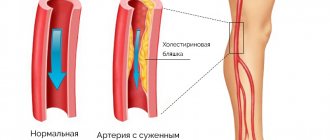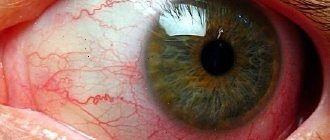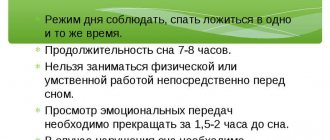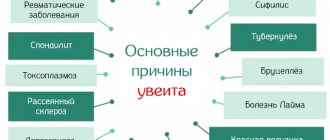Causes
There are the following reasons that provoke the development of angiopathy in children:
- deviations in the innervation of blood vessels, leading to a decrease in their tone;
- autoimmune pathologies;
- diabetes;
- traumatic brain injury leading to impaired blood circulation in the brain;
- increase or decrease in blood pressure;
- systemic pathologies of the hematopoietic organs;
- insufficiency of the cardiovascular system;
- hereditary factors in the structure of large and small blood vessels;
- oxygen starvation of the fetus in late gestation or during childbirth;
- congenital malformations of the baby;
- cervical spine injury during childbirth;
- mechanical damage to the eyes;
- deterioration of the environmental situation;
- increased intracranial pressure values.
The mechanism of pathology development
The disease is formed as a result of disruption of the normal innervation of the fundus of the eye. It is provoked by certain systemic diseases that affect various vessels.
The immune system of an infant is still developing. His body is more prone to the occurrence of pathologies caused by external or internal causes. Some childhood diseases can pass without a trace, or can cause incurable organic defects. One of them is angiopathy.
In newborns, angiopathy can develop due to excessive plethora of veins. It is detected during an ophthalmological examination. An increase in intracranial pressure also leads to the fact that the blood supply to the retina is overloaded.
Classification
Depending on the factors, the following types of retinal angiopathy are distinguished:
- Diabetic. It is typical for children suffering from type 1 diabetes. Treatment of the disease is quite complicated due to the progression of retinal damage.
- Traumatic. This angiopathy is a consequence of injuries during childbirth, bruises of the chest, head, and abdomen. In children, this form of pathology is the most common.
- Hypertensive. This form of angiopathy occurs due to hypertension. In children, it most often occurs in a malignant form and causes persistent circulatory problems in the eye. Venous vessels become more tortuous, their lumen increases. Arterial vessels become thinner and more fragile. Hypertension increases the risk of retinal hemorrhage.
- Hypotonic. Angiopathy develops as a result of a persistent decrease in blood pressure. The tone of the vessels becomes reduced, their lumen expands.
- Juvenile, or Eales syndrome. With this disease, the veins in the fundus become inflamed. The disease is dangerous because the retina and vitreous body are gradually replaced by fibrous tissue. This is the most dangerous type of retinal damage. In older age, Eales syndrome causes glaucoma - a persistent increase in intraocular pressure, cataracts (clouding of the lens). The etiology and pathogenesis of Eales syndrome have not been fully studied.
Nutrition correction
The features and composition of the diet for a child directly depend on the type of pathology that caused angiopathy. If the primary source is a sharp increase in blood pressure, then it is necessary to limit the consumption of salt and spices, spicy and fatty foods.
In cases where the pathology is a consequence of diabetes mellitus, the child must be fed strictly in accordance with medical recommendations for this type of disease. Recommended Products:
- Lean meat (beef, veal, rabbit) and liver in small quantities.
- Poultry (chicken and turkey).
- Dairy products: milk, low-fat cottage cheese, light cheese, sour cream in limited quantities.
- Butter and vegetable oil.
- Eggs. It is preferable to give your child 1 egg per day. It is recommended to limit or completely eliminate yolks.
- Vegetable soups with meat or mushroom broth.
- Cereals. They must be given in limited quantities, because this product contains a large amount of carbohydrates. We recommend giving preference to buckwheat, barley, wheat, pearl barley and oatmeal.
- Rye or bran bread.
What to exclude:
- Fatty and smoked meat.
- Fatty fish species.
- Duck and goose meat.
- Canned food.
- Sour-milk products, salty and sweet cheeses.
Fast food and an abundance of sweets must also be excluded from the child’s diet.
Symptoms
General signs of childhood angiopathy are:
- subtle hemorrhages in the eyes;
- decreased visual acuity, especially at distance;
- loss of vision in one or both eyes;
- nose bleed;
- the appearance of blood in the urine;
- pain in the lower extremities;
- itching in the eyes;
- the appearance of a veil before the eyes;
- all surrounding objects seem blurry;
- flashes of bright light appear before the eyes.
With angiopathy associated with changes in blood pressure, the following symptoms may appear in older children:
- severe anxiety;
- fatigue while watching TV or reading books;
- the child has a desire to rub his eyes;
- the appearance of red spots (they indicate that small vessels have burst);
- the appearance of spots on the eyeballs;
- the child complains about lightning, spots in front of the eyes and other phenomena;
- bleeding from the nose.
Sometimes angiopathy can be suspected by the child’s behavior: he tries to sit closer to the monitor screen or place toys closer to his eyes. Children incorrectly determine the shape of objects and their color.
Diagnostics
First of all, you need to diagnose the disease that led to the development of retinal angiopathy. The main method of examination is ophthalmoscopy. In this case, the surface structure of the eye is studied using an ophthalmoscope.
During fluorescein angiography of the fundus, a luminous radiopaque substance is injected into the blood vessels, which is completely safe for the body.
Electroretinography is a method that allows you to detect the slightest changes in the bioelectrical activity of the retina against the background of a deterioration in its blood supply. An additional examination method is perimetry – a diagnostic examination that measures the patient’s field of vision.
If there is no cause for the disease, then consultation with specialists may be required.
Definition of disease
Angiopathy is a condition of the vessels of the organ of vision in which pathological changes occur. That is, they may turn out to be narrowed, tortuous, or expanded. All these changes are caused in most cases by quite serious diseases, such as diabetes mellitus and hypertension. Pathology of blood vessels can also occur after injury. And also the inflammatory process in the retina is not excluded in case of tuberculosis, toxoplasmosis, dystrophy in a child. The blood supply to the inner lining of the eye deteriorates, and it begins to function worse.
Treatment
The effectiveness of angiopathy therapy depends on the timeliness and adequacy of therapeutic measures aimed at correcting diabetes, eliminating the consequences of injuries, getting rid of hypertension and other pathologies.
Usually the doctor prescribes medications that have a positive effect on local blood circulation. In some cases, agents are indicated to prevent platelet aggregation. These products should not be used to treat infants. Self-medication with folk remedies can be life-threatening.
For angiopathy, the doctor may prescribe vitamin and mineral complexes. They have a healing effect on the body and metabolism in the tissues of the eye.
The following physiotherapeutic procedures are prescribed:
- magnetic therapy (to restore normal blood circulation);
- acupuncture (helps with angiopathy caused by high blood pressure);
- irradiation with laser beams (the procedure restores normal blood circulation, strengthens the walls of the arteries and veins of the fundus);
- chromotherapy;
- wave pneumomassage.
A diet excluding fatty, salty, and sweet foods is recommended.
If conservative treatment does not produce results, then surgical intervention is resorted to.
How is the disease treated in children?
Retinal angiopathy is a symptom of another disease, so the disease that caused it must be treated. Having discovered this disease, the doctor prescribes an examination to find out the causes of its occurrence and after that complex treatment is prescribed.
In parallel with the treatment of the underlying disease, the fundus of the eye is treated. Most often, drugs are prescribed to improve blood microcirculation. After the underlying disease is cured, angiopathy disappears without a trace.
Since the anomaly is a secondary process, the treatment strategy depends on the underlying cause of the disease. In addition to the main therapy, the ophthalmologist usually prescribes:
- drugs that improve blood circulation and strengthen the walls of blood vessels;
- complex vitamins;
- Physiotherapeutic treatments may be offered;
- in extreme cases, surgery is performed.
Making a diagnosis is the reason to adjust the child’s lifestyle. Be sure to spend more time in the fresh air, provide adequate nutrition and light physical activity, and protect from head and neck injuries.
But there are often cases when, with minor manifestations of the disease, the doctor chooses a wait-and-see approach. Indeed, in children, especially infants and newborns, the condition returns to normal without additional interventions.
It has been noticed that the condition of the fundus vessels sometimes changes depending on the position of the child’s body. In some children, when they sit, the blood vessels narrow, while in others, on the contrary, they increase; it all depends on the individual characteristics of the person. Therefore, many doctors believe that special treatment for angiopathy is not required.
If treatment measures are carried out correctly and in a timely manner, visual function will be restored. The treatment is complex, using medications, special physiotherapeutic procedures and surgery.
To restore hemodynamics and trophism of the retina, the doctor treats:
- Solcoseryl.
- Pentilin.
- Arbiflex.
- Vazonite.
- Trental.
- To strengthen the vascular walls, you need to take multivitamin preparations containing vitamins A, E, C, PP.
Physiotherapeutic procedures include wave pneumomassage, chromotherapy, magnetic therapeutic and acupuncture effects, and laser treatment.
Dietary nutrition has a direct relationship with the root causes of angiopathy. If the root cause of the disease is high blood pressure, then maximum restriction of salt intake is necessary.
If angiopathic changes appear as a result of diabetes mellitus, then dietary nutrition should prevent an increase in blood sugar.
Important
It should be remembered that childhood angiopathy is a serious pathological process caused by another pathology. It is better not to delay treatment, otherwise the process will become irreversible.
In order to protect blood vessels, angioprotectors are prescribed for oral administration, helping to strengthen the walls of blood vessels, prevent hemorrhage and the formation of blood clots. Physiotherapy has a good effect in treating the disease: laser irradiation, electrophoresis, magnetic therapy, vitamins.
As you can see, retinal angiopathy in a child is not an incurable disease, however, you need to visit an ophthalmologist and have the fundus diagnosed. Correct and timely treatment allows (in most cases) to completely cure the disease and reduce the risk of pathology to a minimum.
Useful video
More information can be found at the following links:
The eyes are a unique organ that requires close attention. The presence of angiopathy does not mean loss of vision. Parents' attention to their children is the key to their health.
Author's rating
Author of the article
D. Aleaxndrescu
Articles written
2031
about the author
Was the article helpful?
Rate the material on a five-point scale!
If you have any questions or want to share your opinion or experience, write a comment below.
